Exploring the Criteria for the Evaluation of Scientific Evidence in Free Trade Agreements
DOI:
https://doi.org/10.71016/hnjss/j87tr132Keywords:
WTO, GATT, Scientific Evidence, SPS Agreement, Technical Barriers to TradeAbstract
Study Background: For a long period, the standards of the Sanitary and Phytosanitary (SPS) Agreement were the only scientific conditions incorporated in WTO agreements (WTO). Notwithstanding this, the use of science to international trade law extends far beyond the SPS Agreement. The argument between Australia and Plain Packaging has demonstrated that there may be subtle scientific factors involved in the evaluation of non-SPS solutions. Also, free trade agreements and other types of preferential trade should be discussed (PTAs).
Aim of the Study: With this context in mind, this study looks into the elements that may influence the necessity for scientific proof in PTAs.
Methodology: This study uses a standard textual analysis approach, together with some noteworthy methodological considerations, to locate and interpret PTA clauses. Keywords search was done to make sure everything is mentioned in trade agreements. Each possibility has been explored in this exhaustive investigation.
Findings: In light of these recent developments, it appears that the scientifically based SPS rules may be applied to a broader variety of TBT sections. Others merely introduced additional scientific proof criteria in the WTO-X on regulatory cooperation, the environment, and labour.
Conclusion: To summarise, the author believes that the function of scientific evidence canons in PTAs deserves far more attention than it now receives. To achieve the objective qualitative method by utilizing international agreement, convention and protocols has been used.
Downloads
Published
Issue
Section
License
Copyright (c) 2023 Naheeda Ali (Author)

This work is licensed under a Creative Commons Attribution-NonCommercial 4.0 International License.








